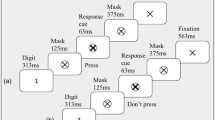Abstract
Although many children with early infantile autism cannot maintain attention to externally imposed tasks, they may continue a repetitive behavior of their own choosing for long periods of time. This study examined the performance of autistic and mental age matched normal children on a Continuous Performance Test of sustained attention. Results suggest that autistic children's difficulties in sustaining attention on imposed tasks may be attributable partly to a developmental delay and partly to the motivational contingencies of task rather than to a primary impairment in the ability to sustain attention.
Similar content being viewed by others
References
Carr, E. (1977). The motivation of self-injurious behavior: A review of some hypotheses.Psychological Bulletin, 84, 800–816.
Clark, P., & Rutter, M. (1981). Autistic children's responses to structure and to interpersonal demands.Journal of Autism and Developmental Disorders, 11, 201–207.
Cohen, D., & Johnson, M. (1967). Cardiovascular correlates of attention in normal and psychiatrically disturbed children.Archives of General Psychiatry, 18, 561–567.
Cook, A., Anderson, N., & Rincover, A. (1982). Stimulus overselectivity and stimulus control: Problems and strategies. In R. Koegel, A. Rincover, & A. Egel (Eds.),Educating and understanding autistic children. San Diego: College-Hill.
Dunlap, G., & Egel, A. (1982). Motivational techniques. In R. Koegel, A. Rincover, & A. Egel (Eds.),Educating and understanding autistic children. San Diego: College-Hill.
Durand, V. M., & Crimmins, D. (1988). Identifying the variables maintaining self-injurious behavior.Journal of Autism and Developmental Disorders, 18, 99–118.
Egel, A. (1980). The effects of constant versus varied reinforcer presentation on responding by autistic children.Journal of Experimental Child Psychology, 30, 455–463.
Fein, D., Waterhouse, L., & Trader, P. (1979). Stimulus generalization in autistic and normal children.Journal of Child Psychology and Psychiatry, 20, 325–335.
Fein, D., Waterhouse, L., Lucci, D., & Snyder, D. (1985). Cognitive sybtypes in developmentally disabled children: A pilot study.Journal of Autism and Developmental Disorders, 15, 77–95.
Ferster, C. (1961). Positive reinforcement and behavioral deficits of autistic children.Child Development, 32, 437–456.
Frankel, F., Freeman, B., Ritvo, E., & Pardo, R. (1978). The effect of environmental stimulation upon the stereotyped behavior of autistic children.Journal of Autism and Childhood Schizophrenia, 8, 389–394.
Gold, M., & Gold, J. (1975). Autism and attention: Theoretical consideration and a pilot study using set reaction time.Child Psychiatry and Human Development, 6, 68–80.
Howlin, P. (1978). The assessment of social behavior. In M. Rutter & E. Schopler (Eds.),Autism: A reappraisal of concepts and treatment. New York: Plenum Press.
Hung, D. (1978). Using self-stimulation as reinforcement for autistic children.Journal of Autism and Childhood Schizophrenia, 8, 355–366.
Hutt, C., & Hutt, S. (1968). Stereotypy, arousal and autism.Human Development, 11, 272–286.
Kinsbourne, M. (1980). Do repetitive movement patterns in children and animal serve a dearousing function?Developmental and Behavioral Pediatrics, 1, 40–43.
Kinsbourne, M. (1983), Toward a model for the attention deficit disorder.Minnesota Symposia on Child Psychology, 16, 137–166.
Koegel, R., & Egel, A. (1979). Motivating autistic children.Journal of Abnormal Psychology, 88, 418–426.
Lovaas, O. (1977).The autistic child: Language development through behavior modification. New York: Irvington.
Lovaas, O., Koegel, R., & Schreibman, L. (1979). Stimulus overselectivity in autism: A review of research.Psychological Bulletin, 86, 1236–1254.
McCarthy, D. (1972).McCarthy Scales of Children's Abilities. New York: Psychological Corporation.
McNicoll, D. (1972).A primer of signal detection theory. London: George Allen and Unwin.
Murphy, G. (1982). Sensory reinforcement in the mentally handicapped and autistic child: A review.Journal of Autism and Developmntal Disorders, 12, 265–278.
Ornitz, E., & Ritvo, E. (1976). The syndrome of autism: A critical review.American Journal of Psychiatry, 133, 609–621.
Rimland, B. (1964).Infantile autism: The syndrome and its implications for a neural theory of behavior. New York: Appleton-Century-Crofts.
Rosvold, H., Mirsky, A., Sarason, I., Bransome, E., & Beck, L. (1956). A continuous performance test of brain damage.Journal of Consulting and Clinical Psychology, 20, 343–352.
Schopler, E. (1965). Early infantile autism and receptor processes.Archives of General Psychiatry, 13, 327–335.
Schopler, E. (1966). Visual versus tactile preferences in normal and schizophrenic children.Journal of Abnormal Psychology, 71, 108–114.
Wilhelm, H., & Lovaas, O. (1976). Stimulus overselectivity: A common feature in autism and mental retardation.American Journal of Mental Deficiency, 81, 26–31.
Wing, L. (1978). Social, behavioral, and cognitive characteristics: An epidemiological approach. In M. Rutter & E. Schopler (Eds.),Autism: A reappraisal of concepts and treatment. New York: Plenum Press.
Author information
Authors and Affiliations
Additional information
This project was supported by an NIMH grant MH 28605 to L. Waterhouse and D. Fein. We appreciate the cooperation of the staff and students of League School, Newton, Massachusetts, and the Nazarene Child Care Center in Beverly, Massachusetts. We gratefully acknowledge the help of Hope Trefry, Dot Lucci, Kaye Cook, and Kathleen Sheber with data gathering and analysis. Ross Rizley, Anne Copeland, Jaqueline Liederman, and Leslie Brody of the Boston University Graduate Program in Psychology provided helpful comments at every stage of this project.
Rights and permissions
About this article
Cite this article
Garretson, H.B., Fein, D. & Waterhouse, L. Sustained attention in children with autism. J Autism Dev Disord 20, 101–114 (1990). https://doi.org/10.1007/BF02206860
Issue Date:
DOI: https://doi.org/10.1007/BF02206860




